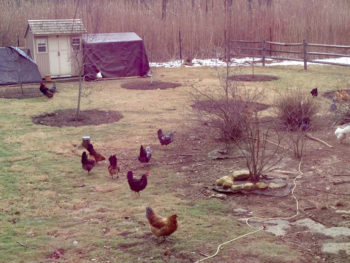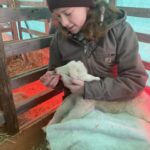In mid-June 2010 we got our first 6 chicks in the mail with the plan that they would eat the ants that were all over one part of our lawn as well as the ticks. Hah! I should have taken it as a sign that one week after getting the chicks I got Lyme Disease and then Bell’s Palsy.
Six years later I realize the absurdity of my expectations and I have stopped referring to our grass as lawn— it is ‘pasture’. (More about that later!). To get rid of ticks on 2 acres you would need upwards of 200 chickens And then there would be so much poop on the lawn that you wouldn’t be hanging out for the ticks to get you anyway! I do think chickens play an important role in a balanced homestead ecosystem but in this part of Connecticut poultry can only go so far to fight the tide, so to speak.
I guess I should tell you that when I started with chickens, I really did not fully realize the extent to which all creatures love the taste of chicken. We have 6”x6” welded wire deer fencing, that is 2”x6” on the bottom, all around our property. It took me a long time before I realized that the fox could easily get through this. I also free ranged the chickens on the full two acres for two years before I realized this didn’t work either. Aerial predators are relentless. We added a rooster in February 2011 and he lasted one month before he was eaten by a predator. That same winter a flock of crows attacked our hens, pecking them and plucking their feathers to death I lost three chickens in that attack immediately and the fourth survivor died the next day. In the first two years we lost 14 chickens to daytime predators. I always lock the chickens up at night and have never lost a chicken that way. I now finally have a system that works and I would like to share it with you.

We let the chickens free range everyday on 1/3 acre. There are some large trees on the boundaries of the field. These provide shade and a general hiding spot from aerial predators. Then there are planting beds with deciduous shrubs which provide seasonal shelter from sun and predators. The fruit orchard (apple and pear trees) is part of their field. There is one Macintosh apple tree that is probably more than 50 years old that young turkeys occasionally play in. And all the poultry enjoy the windfall apples in the fall. The other fruit trees are young so don’t provide shade or shelter (or any fruit for that matter!) but one day the field will be even more lush.

Aerial predators are much less frightening (to me) now that we have the turkeys. Their eyes are always on the watch, especially the toms. And the turkeys have such an extensive range of chirps, calls an burbles with which to communicate with each other, it’s fascinating.
One day this past summer I could hear the turkeys making a fuss although the chickens seemed rather unflustered. I looked up in the tree and saw a kestrel staring down at the flock. The turkeys made it very clear to Mr Kestrel that they knew he was there—that they had their big eyes on him. He sat there for a full half hour before giving up and flying away.
My advice: free ranging hens is pretty much like putting a restaurant sign out for predators. Getting one rooster is slightly better but if someone is going to die it will be your rooster, defending his girls. Having 2 roosters is even better. They have each other’s back and when the head honcho rooster gets taken by a predator, you have a second rooster that has been trained up already. And really, poultry teach each other the do’s and don’ts of free ranging. Having a complete new flock is the hardest because no one knows anything! But the best scenario is your hens with two roosters and two turkeys. Two turkeys because animals can always get sick and die so always have a back-up.
The field perimeter is post and rail fencing on two sides with 2” x 4” galvanized wire stapled to it. It is 4 1/2 – 5 foot tall. The fox can leap over this if he chooses, or jump through a 6” x 6” welded wire square on the other two sides (yes, he has foolishly done this in the past) but usually the fence is enough of a barrier that the turkeys spot him now and kick up a stink while the head rooster tells the hens to hide. The last time we saw the fox, seven months ago, the whole farmyard made so much noise when they spotted him that he hightailed it out of there and we haven’t seen him since!
The only two times we confine the poultry to their runs is: in spring when the fox kits are born and when there is snow on the ground. In the spring for about a month we reduce the free-ranging time to about half of their usual day, just to reduce the odds of an attack. And when there is snow on the ground, the turkeys don’t mind at all but the chickens act as if they are walking across cobblestones in stilettos. And they voluntarily choose to spend a lot of the snow day in the coop anyway. Those two facts combined and they are just sitting ducks with an open coop in the winter.

Yes, having roosters and turkeys changes the dynamic of your interaction with your hens. If you just want docile pets that bow to you as their leader then you will just want to cage your hens, not free range and don’t have a rooster. However, free ranging chickens are in my opinion much happier animals and if it means I have to be more respectful of the rooster’s wishes with his hens so be it. It’s a fair trade.







